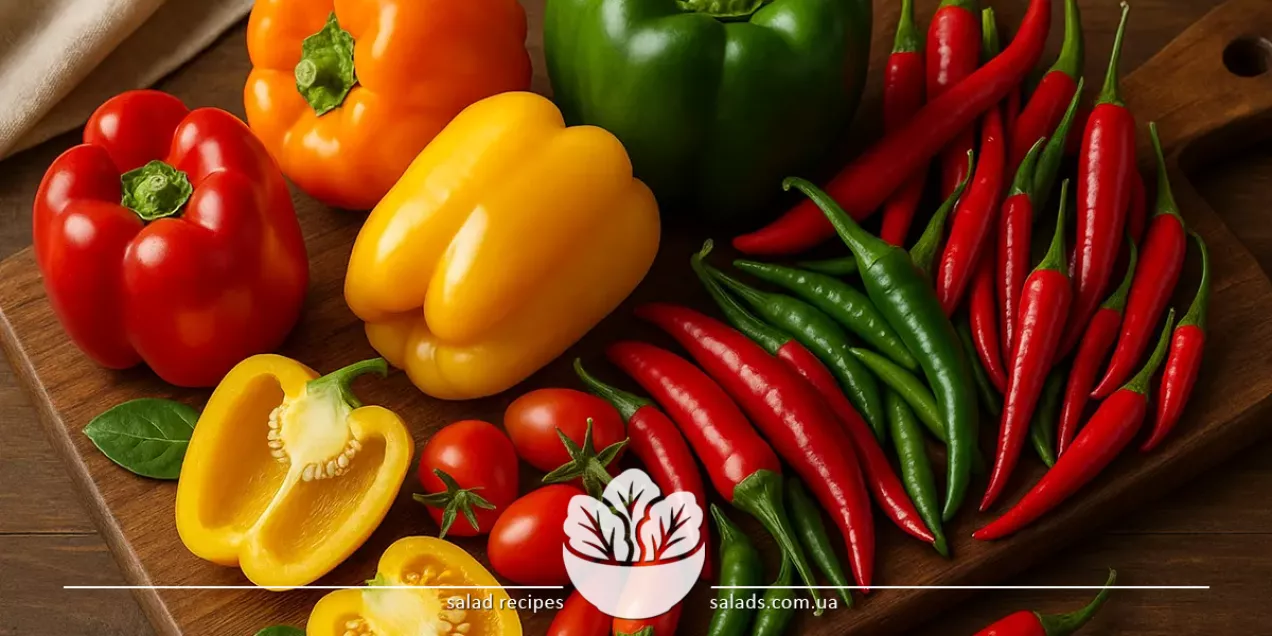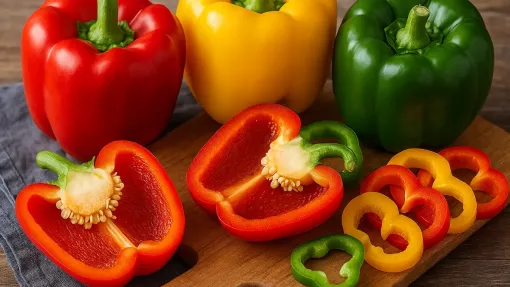Types of Peppers

Peppers are among the most diverse groups of vegetables widely used in cooking as salad ingredients. This category includes all fresh and cooked forms of peppers – sweet bell peppers, hot chili varieties, bitter peppers, pepperoni, as well as pickled and roasted versions that enhance the flavor palette of any dish. Each type has its own texture, color, and spiciness level, allowing salads to range from mild to distinctly spicy. Whether you’re preparing a light summer salad, a warm vegetable dish, or a complex meal with legumes, peppers add both flavor and visual appeal. In the context of salad ingredients, vegetable peppers are not only a colorful addition but also a source of fiber, antioxidants, and vitamins, making them essential for a balanced diet.
Different Types of Peppers
Sweet Pepper Varieties in Salads
Sweet peppers are among the most versatile vegetables used in salads around the world. Their mild flavor, juicy flesh, and vibrant colors make them indispensable in light summer dishes, appetizers, and vegetarian compositions. Sweet varieties include red, yellow, orange, and green peppers, which differ in ripeness, taste intensity, and aroma. Red bell peppers, the ripest, have a sweet flavor and the highest vitamin C content among peppers. Yellow and orange varieties are usually softer in texture and milder in taste, pairing well with soft cheeses, fruits, or oil-based dressings. Green sweet peppers are less sweet, sometimes with a slight bitterness that adds a refreshing note to dishes. They are often used in Mediterranean salads with plenty of greens, tomatoes, and beans. Fresh peppers are typically chopped into cubes, half-rings, or strips depending on the salad type. Roasted or lightly sautéed sweet peppers are also frequently added to warm salads or grain-based dishes, where they offer a rich flavor with caramelized notes.
Thanks to their high content of antioxidants, carotenoids, and vitamins A, C, and B6, sweet peppers are not only healthy but also important for a balanced diet. They pair well with dairy products, cheeses, legumes, boiled chicken, and whole grains. In vegetarian salads, they often serve as a base for colorful combinations with beans, herbs, and fruits. A mix of red peppers with cranberries or pomegranate is a popular option in festive salads. In addition, sweet peppers are often pickled in light vinegar or lemon juice with garlic and oil – a great addition to Central European and Balkan-style salads. In Greek salads, roasted peppers are frequently served alongside feta or olives. Combined with vegetable oil or olive oil, sweet peppers serve as a perfect base for light salad dressings or purees.
Hot and Chili Peppers in Salads
Hot pepper varieties, including various types of chili, are key ingredients in many national cuisines and are increasingly used in modern salads. They add heat, depth of flavor, and distinctive aroma. Common varieties include red and green chili, jalapeño, bird’s eye chili, serrano, and others that differ in spiciness and shape. Using hot peppers in salads requires caution – even in small amounts, they can significantly alter the flavor balance. Fresh chili is often sliced into thin rings or diced and added to light vegetable salads with beans, avocado, corn, or fruits for contrast. In Mexican or Asian salads, chili peppers are a key source of aroma. They’re often combined with fresh herbs, rice, cilantro, or lime for a spicy and refreshing composition. Thai recipes often feature a mix of hot peppers, fish sauce, and lemon juice as the main dressing.
Hot peppers pair well in salads with ingredients that soften their intensity – such as cheese, creamy sauces, or juicy fruits. In salads with mango or pineapple, thinly sliced red chili adds spicy depth without overpowering sweetness. Interesting combinations also include legumes – for example, in salads with chickpeas, lentils, or beans, where the heat is balanced by grainy texture. In some cases, peppers are pickled – either alone or with other vegetables. These are added to salads just before serving to introduce a bright sour or tangy-spicy note. Pickled chili works particularly well in grain-based salads and with cooked vegetables. When using fresh or pickled hot peppers, it’s important to consider individual spice tolerance and adjust the amount, as even a small piece can significantly change the dish’s character.
Pickled and Roasted Peppers
Pickled and roasted peppers make excellent salad ingredients, adding richer flavor, intensity, and textural variety. Both sweet and hot pickled peppers are widely used in Mediterranean, Balkan, and Middle Eastern cuisines. Their distinctive sweet-sour or spicy flavor complements cheese, meat, grains, and other vegetables. Most commonly, red sweet peppers are pickled in vinegar, olive oil, and spices for use in salads. These have a bold flavor, store well, and retain their color. Roasted peppers – particularly red or yellow – are frequently used in warm salads or layered dishes. Roasting reduces moisture, softens the taste, and creates a tender texture. In salads, roasted peppers are often combined with grains, nuts, soft cheeses, greens, and oil. Roasting also makes it easier to peel the skin, which improves texture – especially in dishes for children or those sensitive to fiber.
Pickled varieties such as sweet bell peppers or tangy-spicy pepperoni are often included in jarred salads. They’re convenient for quick meals that require no cooking or chilling. These peppers pair well with proteins like eggs, canned tuna, or chicken. Pickled peppers also match fruity ingredients like grapes or baked apples, offering bold contrasts in flavor and texture. It’s worth noting that roasted and pickled peppers are often used as a base in vegetarian or vegan salads, replacing heavier ingredients like meat or cheese. These salads absorb flavors of smoke, spices, or balsamic vinegar retained in the roasted flesh. It’s also popular to mix several types of peppers – fresh, roasted, and pickled – in one salad for complex texture and taste. This approach makes the dish suitable for any season or culinary style.
Pairing Peppers with Other Vegetables and Salad Components
Peppers, regardless of variety, pair well with many other salad ingredients. Their versatility allows for light, vitamin-rich mixes or complex, multi-ingredient meals. In classic vegetable salads, sweet peppers are often combined with tomatoes, cucumbers, onions, and herbs for a fresh and balanced taste. Hot varieties like chili enhance flavor complexity, especially with sweet-sour fruits, aromatic greens, or Asian dressings. Peppers also pair well with protein-rich ingredients: chicken breast, eggs, fish, legumes, or cheese. For example, a salad with bell pepper, canned tuna, and beans is a filling dish rich in protein and fiber. Combined with olive oil and balsamic vinegar, peppers create a harmonious flavor and acidity balance. They are also used with grains – couscous, bulgur, barley – in hearty Mediterranean or Eastern-style salads.
Among less typical combinations are salads that pair peppers with fruits – such as peach, raspberry, or mango. Sweet peppers balance fruit acidity and juiciness, while adding vibrant color. In complex dishes, multiple pepper types are used at once – for example, red sweet pepper, fresh chili, and pickled green pepper – to create a visually rich and layered flavor composition. Herbs are another element that pairs well with peppers. In salads with spinach, arugula, basil, or parsley, peppers serve as accents that add crunch and color. Particularly interesting are combinations with aromatic herbs that soften chili’s heat or highlight red pepper’s sweetness. In such recipes, the right dressing matters: light oils, lemon juice, or wine/apple vinegar work best. Combining peppers with vegetables, proteins, fruits, and greens offers plenty of room for experimenting with texture, flavor, and color – making them a highly valuable ingredient in creative cuisine. They can serve as the foundation of a salad or as a flavor accent that changes the dish’s overall character depending on preparation and pairing.
How to Choose Peppers for Salads
Choosing the right peppers for a salad depends on several factors: dish type, desired flavor, texture, color palette, and even season. For fresh vegetable salads, sweet peppers – red, yellow, or green – are ideal. Red peppers offer a rich, sweet flavor and soft texture, making them great with soft cheeses or fruits. Yellow and orange varieties are mildly aromatic and combine well with herbs, while green peppers go better with strong-flavored ingredients like capers, olives, or beans. Hot peppers, especially fresh chili, should be added in small amounts, keeping individual spice tolerance in mind. It's a good idea to taste them beforehand, as heat levels can vary widely even within one variety. For exotic salads with Asian or Latin American influences, red or green chili sliced into strips or rings works well. Hot peppers pair nicely with sweet or neutral ingredients like fruits or dairy products.
Pickled peppers are best suited for grain-based salads, legumes, or roasted vegetables. Their bold flavor can dominate a dish, so quantities should be moderated. Roasted peppers are perfect for warm salads or main dishes without meat. Choose ones with firm flesh that hold their shape after roasting and don’t turn to puree. For ease, it’s best to remove the skin – it may be tough or bitter after cooking. Color also matters: red or orange peppers add visual highlights, while green offers a refreshing appearance. Using multiple pepper varieties in one salad creates both a well-balanced flavor profile and a visually appealing presentation. Seasonality is important too: use fresh local varieties in summer, and pickled or roasted ones in winter, as they preserve their properties longer. Peppers aren’t just a salad add-on – they are full-fledged ingredients that can serve both decorative and flavor-enhancing roles. Their versatility makes it easy to prepare light, nutritious, and balanced dishes suitable for any cuisine or dietary preference.
